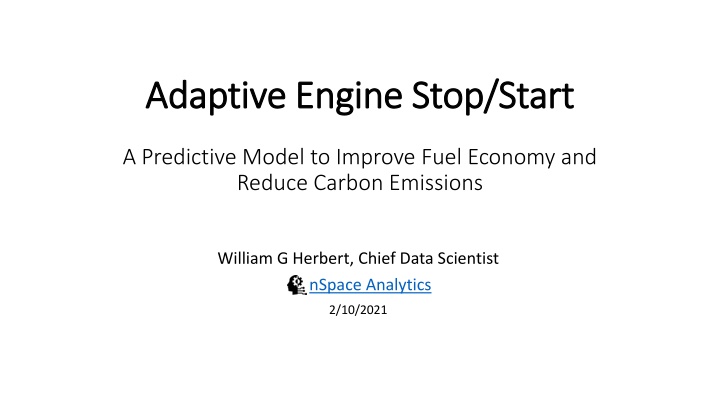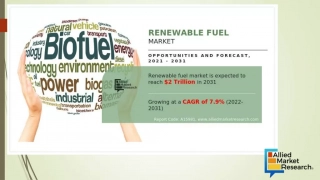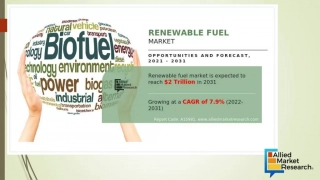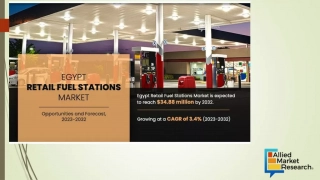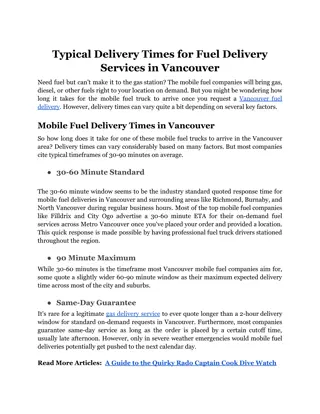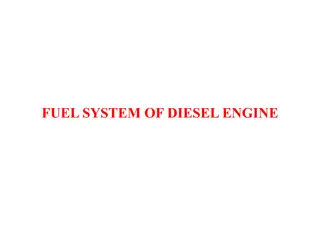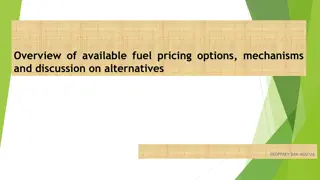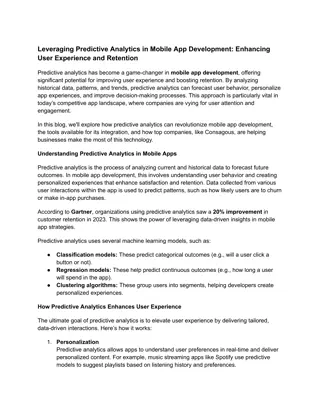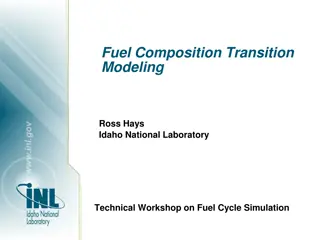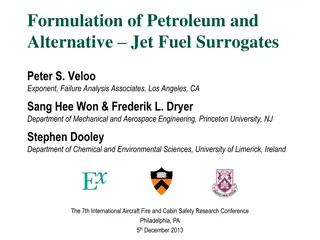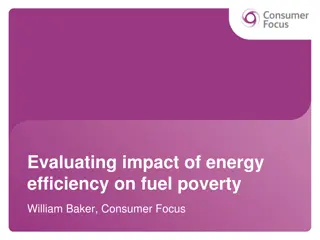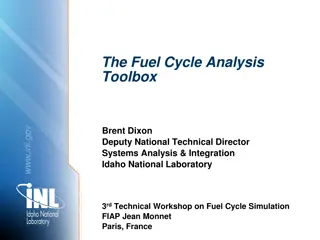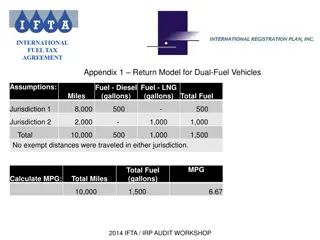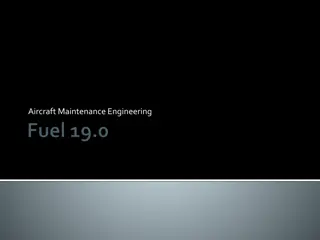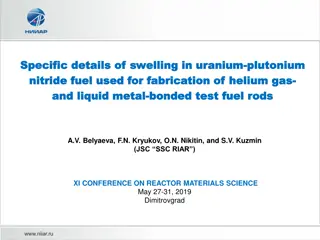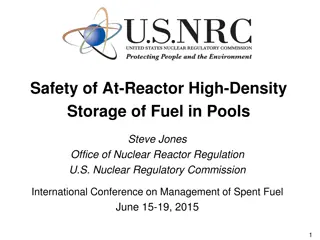Adaptive Engine Stop/Start Predictive Model for Improved Fuel Economy
The Adaptive Engine Stop/Start algorithm utilizes machine learning to predict vehicle stops and optimize fuel efficiency, reducing carbon emissions. It enhances single vehicle performance and fleet operations through innovative AI techniques. By classifying driver/vehicle pairs and predicting upcoming stops, this technology represents a significant advancement in automotive applications.
Uploaded on Apr 13, 2025 | 2 Views
Download Presentation

Please find below an Image/Link to download the presentation.
The content on the website is provided AS IS for your information and personal use only. It may not be sold, licensed, or shared on other websites without obtaining consent from the author.If you encounter any issues during the download, it is possible that the publisher has removed the file from their server.
You are allowed to download the files provided on this website for personal or commercial use, subject to the condition that they are used lawfully. All files are the property of their respective owners.
The content on the website is provided AS IS for your information and personal use only. It may not be sold, licensed, or shared on other websites without obtaining consent from the author.
E N D
Presentation Transcript
Adaptive Engine Stop/Start Adaptive Engine Stop/Start A Predictive Model to Improve Fuel Economy and Reduce Carbon Emissions William G Herbert, Chief Data Scientist nSpace Analytics 2/10/2021
Algorithm Description Algorithm Description The Adaptive Stop/Start Algorithm predicts instances in which a vehicle is expected to come to a stop within 15 seconds. In such cases, the vehicle s internal combustion engine is immediately shut down. The engine is restarted when the driver depresses the accelerator pedal. Current engine stop/start technology does not stop a vehicle s engine until the vehicle has come to a full stop. Adaptive Engine Stop/Start builds on this rudimentary technology, further improving fuel economy and emissions reductions by shutting down the engine while the vehicle is approaching a stop but is still in motion. Advancing engine shutoff to occur 15 seconds before vehicle stop provides clear improvement in fuel savings and emissions reduction at each engine stop event. More importantly, the technology represents a significant advance in the utilization of machine learning and predictive modeling in automotive applications, as the current stop/start approach involves little use of artificial intelligence. Looking to the future, the predictive model employed in Adaptive Stop/Start can be extended far beyond mobility applications to almost any domain in which data- driven predictions of upcoming events would be useful. 4/13/2025 nSpace Analytics - Adaptive Engine Stop/Start page 2
Algorithm Scope Algorithm Scope The Adaptive Engine Stop/Start Engine addresses the challenges of improving fuel economy and minimizing carbon emissions from two important perspectives: 1. Single Vehicle Performance Enhancement The proposed algorithm provides a mechanism that can be optimized for an individual vehicle. This is the perspective of concern to independent drivers and vehicle owners. 2. Optimization of Fleet Performance Because it classifies vehicle/driver pairs into clusters that exhibit common characteristics, Adaptive Stop/Start provides an opportunity to improve performance of collections of vehicles. This is a perspective of importance to both fleet operators and vehicle manufacturers. 4/13/2025 nSpace Analytics - Adaptive Engine Stop/Start page 3
Algorithm Components Algorithm Components Adaptive Engine Stop/Start is implemented via a novel two-step Artificial Intelligence Machine Learning model: 1. Driver/Vehicle Classification Using a K-Means Unsupervised Learning Clustering model, driver/vehicle pairs are classified into clusters based on their speed and acceleration through a set of controlled intersections. Such pre- classification leads to far greater accuracy in the subsequent prediction step than might otherwise be experienced. The three driver/ vehicle classes are: Less-Aggressive Average More-Aggressive 2. Prediction of Upcoming Vehicle Stops A CART Decision Tree Supervised Learning Model uses a mix of vehicle sensor data and driver input data to predict situations in which a vehicle will come to a full stop in 15 seconds. 4/13/2025 nSpace Analytics - Adaptive Engine Stop/Start page 4
Research Database Research Database The Adaptive Stop/Start Algorithm is built on data extracted from the Strategic Highway Research Project (SHRP2) Naturalistic Driving Database Incorporates data from 3,000 driving trips in urban and rural areas of 6 U.S. regions. This database was created by the Virginia Tech Transportation Institute in 2015 The following major components of the database are used: Intersection Dataset This dataset of more than 30,000 intersections is used to classify vehicle/driver pairs based on their speed and acceleration through controlled intersections. Time-Series Driving Dataset From this dataset of more 40,000 miles of naturalistic driving, time-series data for 16 vehicle/driver pairs is utilized. Each of these time-series sequences ends at a stop at an intersection identified in the Intersection Dataset. 4/13/2025 nSpace Analytics - Adaptive Engine Stop/Start page 5
Decision Tree Representation Decision Tree Representation Sample Node Sample Node Node Parameter Within each node, the model splits data into 2 subsets (sub-nodes) based on whether data set elements satisfy the parameter condition. Elements that satisfy the condition go to the left sub-node, others go to the right sub-node. Gini Impurity At each node, the model selects parameters that provide for the largest split. At this depth 0 node, the split is 50 50, thus producing a gini value = 0.5. speed <= 0.703 gini = 0.5 samples = 1083 value = [548, 536] Value At this node, 548 values predict no stop in 15 seconds. 536 values predict stop in 15 seconds. Tree Depth 0 engRPM <= 0.562 gini = 0.097 Samples = 373 Value = [354, 19] gasPedalPosition <= 1.373 Gini = 0.397 Samples = 711 Value = [194, 317] Tree Depth 1 This Abbreviated representation shows Depth 0 and Depth 1 only Greater depth of Full Trees (slides 11 13) improve model accuracy 4/13/2025 nSpace Analytics - Adaptive Engine Stop/Start page 6
Decision Tree Predictive Model Parameters Decision Tree Predictive Model Parameters Predictors Vehicle Data captured from vehicle sensors Speed (kph) Acceleration (g) Engine RPM (rpm) Gas Pedal Position (0 to full application, normalized to the range 0 1) Brake Pedal State (no brake = 0, brake pedal depressed = 1) Derived Data calculated by the model PrevSpeed (speed at previous timestamp, where timestamps occur at a 0.01 hz. rate PrevAccel (speed at previous timestamp) consecTimesteps_negAccel (count of consecutive timestamps during which subject vehicle experiences acceleration <= 0) consecTimeseps_brakeInMotion (count of consecutive timestamps during which subject vehicle is moving and the brake pedal is depressed) Model Output (predicted for each input timestep) Stop Within 15 Seconds (no = 0, yes = 1) 4/13/2025 nSpace Analytics - Adaptive Engine Stop/Start page 7
Prediction Accuracy Prediction Accuracy Confusion Matrix - Expresses the accuracy of the prediction model Actual Outcomes Count of No-Stop Predictions Count of Stop Predictions Vehicle does NOT stop in 15 seconds 880 Correct Predictions (True Negative) 68 Incorrect Predictions (False Positive) Vehicle stops in 15 seconds 36 Incorrect Predictions (False Negative) 943 Correct Predictions (True Positive) Composite Model Accuracy (all classes combined) = (Total predictions incorrect Predictions)/ Total Predictions = (1823 (68 + 36)) / 1823 = 94.3 % 4/13/2025 nSpace Analytics - Adaptive Engine Stop/Start page 8
Analysis of Model Errors Analysis of Model Errors While the high overall accuracy of this model is important, equally important is the impact of incorrect predictions, how they occur, and how they are handled. False Negatives (incorrectly predicted no-stops) False negatives of this type tend to occur at 15 seconds before actual stops, and at very few stop events. Their effect is to delay engine shutdown for one or two tenths of a second, at most. The few that occur after engine shutoff have no effect. False Positives (stops are falsely predicted causing unexpected and unnecessary engine shutoffs). Such engine stops would constitute a serious irritant and distraction to drivers. For this model, false positives are few in number. They tend to occur in clusters, the largest of which was observed to span 9 timesteps. These false positives can be negated by not shutting off a vehicle s engine unless several consecutive stop predictions are detected. Requiring 10 consecutive stop predictions before shutdown would negate all false-positives and delay engine shutdown by only one second (i.e. 10 timesteps of 0.1 second each) 4/13/2025 nSpace Analytics - Adaptive Engine Stop/Start page 9
Depth 5 Decision Tree Depth 5 Decision Tree Less Less- -Aggressive Driver Class Aggressive Driver Class Prediction Accuracy: 93.1% The data for this sub-class prediction tree consisted of six 30-second driving events logged by the six members of the Less- Aggressive driving class. 4/13/2025 nSpace Analytics - Adaptive Engine Stop/Start page 10
Depth 5 Decision Tree Depth 5 Decision Tree Average Driver Class Average Driver Class Prediction Accuracy: 93.7% The data for this sub-class prediction tree consisted of four 30-second driving events logged by the four members of the Average driver class. 4/13/2025 nSpace Analytics - Adaptive Engine Stop/Start page 11
Depth 5 Decision Tree Depth 5 Decision Tree More More- -Aggressive Driver Class Aggressive Driver Class Prediction Accuracy: 97% The data for this sub-class prediction tree consisted of six 30-second driving events logged by the six members of the More-Aggressive driver class. 4/13/2025 nSpace Analytics - Adaptive Engine Stop/Start page 12
Implementation Implementation Research Phase Research Phase The motivation for this research project was the desire to establish Proof of Concept for the proposed Adaptive Stop/Start Algorithm. The model is build around the Scikit-Learn K-Means and Decision Tree classifiers. K-Means is used for river/vehicle classification, while Decision Trees are used for prediction of upcoming vehicle stops. The model is coded in Python in a Jupyter Notebook. Data cleaning, preparation, normalization and other necessary data-wrangling was performed in SQL Server. 4/13/2025 nSpace Analytics - Adaptive Engine Stop/Start page 13
Implementation Implementation Next Steps Fleet Applications 1. Required parameters (vehicle sensor data) are extracted from the Controller Area Networks (CAN bus devices) of all fleet vehicles. 2. Data is transmitted, via modems, to a cloud-based aggregator/processor for driver/vehicle classification and model building. 3. Resulting algorithms are transmitted back to the fleet and installed in the Electronic Control Units (on-board computers) of all vehicles. 4. The vehicles will process the algorithms locally, using real-time sensor data extracted from the CAN bus. 5. Time-series vehicle data is transmitted back to the aggregator for post-processing and trip analysis Non-Fleet Vehicles Since independently-operated vehicles functions as classes of size = 1, the classification step is not needed. The stop/start algorithm, without classification, is installed on stand- alone host vehicles for local processing (similar to Step 4, above ). 4/13/2025 nSpace Analytics - Adaptive Engine Stop/Start Next Steps page 14
